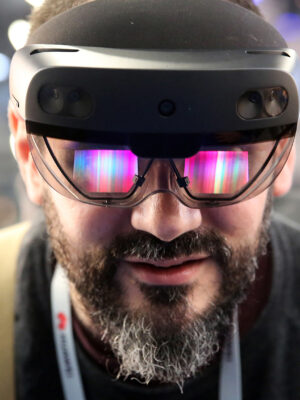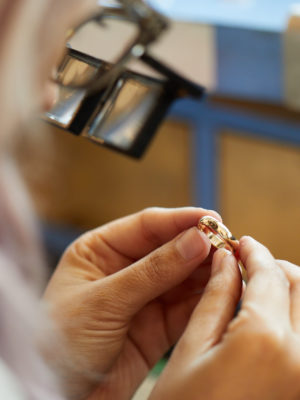Wearable technology is a part of millions of people’s daily lives, with the Apple Watch alone accounting for 100 million wearers. Many wearables have been designed to resemble rings (like Oura, which has sold 500,000 units), bracelets, earpieces and necklaces – drawing on ergonomic principles of jewellery – but more significantly, with a clear understanding that these familiar forms help to ease the hesitancy to connect our bodies to technology. Wearables introduce a new context to how we use technology in our daily lives, as it becomes increasingly intuitive, creating biofeedback and reading our movements, rather than technology being contained within objects which we pick up and put down. As we move into an age of symbiosis between machines and humans, it’s significant that jewellery-like forms are the gateway by which the public will begin to adopt new ways of working, socialising, learning and being entertained.

In wearable AR and VR technology, the Microsoft Hololens 2, and Google Glass Explorer Edition are currently available, and speaking in July 2021, Mark Zuckerberg told The Verge: “about people not working in a VR helmet all day long […] I think we’re going to be there by the end of this decade.” The advent of 5G, the large scale adoption of online shopping during lockdown for so many territories which formerly resisted it, and the number of smartphone users reaching 5.22 billion by the end of 2020 (which represents 66% of the world’s population) are all factors which confirm our arrival at a pivotal point of human history, as our lives become increasingly phygital, shifting en masse from physical to evermore digital existences.

For the moment, the burgeoning art of digital jewellery is primarily showcased through social media, particularly Instagram. With many artists and creatives venting their disdain for Instagram as a creative platform, in the short-term future, we are likely to see large-scale abandonment of the site, and begin to experience a more fractured, but highly individualised internet. As we decamp from big ‘free’ content platforms to smaller online communities, we will experience highly curated spaces which localise the internet – as though we are visiting multiple virtual galleries every day. This is where artists of all disciplines will be able to reaffirm their power: in the patronage of those who seek their art, without AI and data mining being the principle function of the digital space displaying their art.

Digital art, particularly NFTs, have the ability to morph in response to external events. This possibility of redesigning something which you own is an idea which has the potential to completely change the conventional artist/patron/consumer dynamic – the relationship between consumer and creator can be lifelong, and even last beyond singular relationships. These artworks can continue into the ether throughout time, and still exist as readable code once the last of us is extinct.

Will digital jewellery only satisfy mainstream consumers when they can be ‘worn’ in virtual spaces? In the immediate future, digital jewellery is likely to increasingly appeal to a certain niche of jewellery fans – as well as design, technology and crypto enthusiasts – who are Millennial and Gen Z. Unstable traditional financial markets have investors looking to emerging markets like this, so it seems that luxury brands collaborating with tech companies and digital artists will be leading the charge in digital dressing entering the mainstream consciousness. Throughout our collective history, ancient and inexplicable instincts have lay at the heart of why we wear and collect jewellery, and these instincts won’t cease as we move our lives increasingly into the metaverse.
This is the fifth out of five articles on Digital Jewellery commissioned by Current Obsession and written by Jodie Marie Smith.
This series seeks to explain, suggest, hypothesise and forecast the landscape of digital jewellery in our immediate and short term futures. From today’s NFTs, blockchain gems and cryptocurrency diamond auctions, to the metaverse of VR, gaming and the social networks of internet 3.0 – jewellery has evolved beyond the physical, beyond the bounds of our reality, and beyond all definition.
Jodie Smith is a San Francisco based writer, trend forecaster and creative consultant specialising in the jewellery industry. Newly transplanted from London with a background in fine jewellery, Jodie has written for The Future Lab, Rapaport, 1st Dibs, Adorn Insight, The Adventurine, Retail Jeweller, Jewelry Connoisseur and The Jewellery Cut, amongst others. Uniquely positioned between journalists, diamond specialists, luxury brands and digital artists, she reports on every facet of the jewellery world – from the designs we covet, to consumer identities and the our digital futures.
*cover image by Oura smart ring





